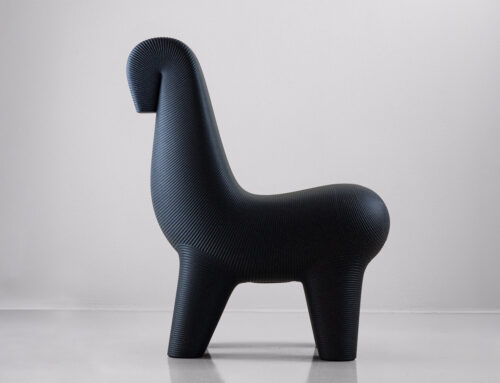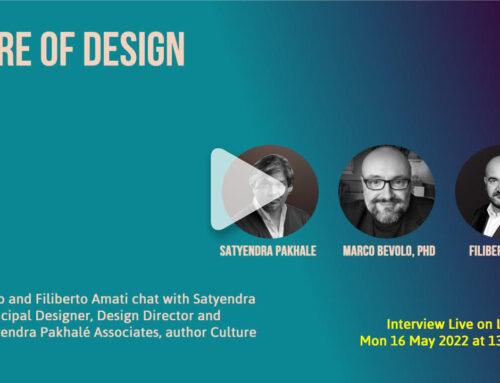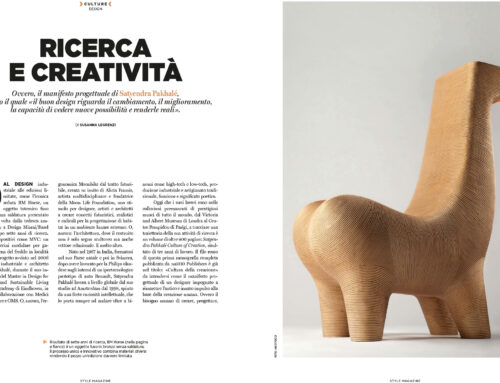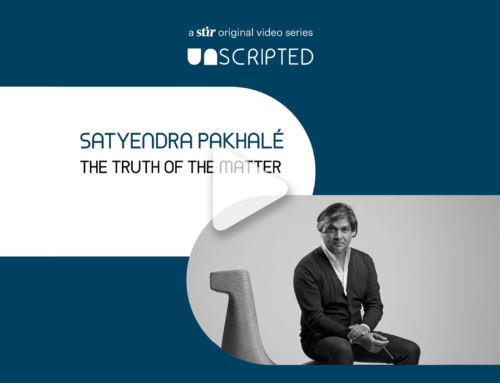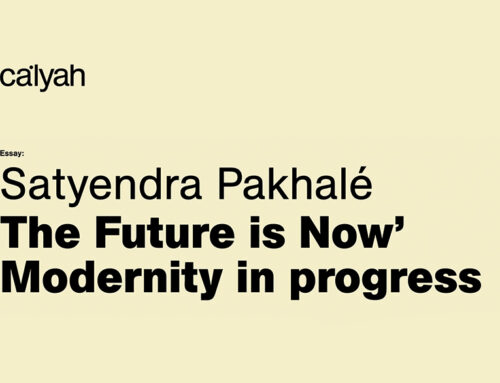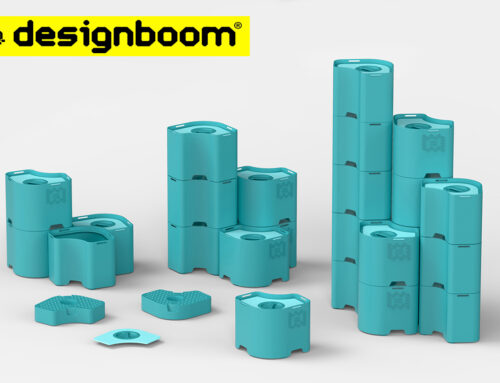Satyendra PAKHALÉ1, Tiziana PROIETTI2 / 4th International Congress on Ambiances, University of California, Santa Barbara (UCSB)-2020/2021, USA
As human beings we are constantly immersed in different atmospheres and spontaneously associate them with space. We propose here to focus on atmospheres of objects. In over more than two decades of experience with Satyendra Pakhalé Associates, we have developed a research program complementary to studio practice. While designing objects we investigate their related atmospheres and cultivate a deep understanding of human perception and sensoriality referring to multiple sources. With the intention to empower the ability of objects to contribute to the broadest necessities of human – social and sensorial – being, here we focus attention on the invisible aura that surrounds objects and evokes specific feelings. We call this holistic practice as ‘Culture of Creation’.
Introduction
We live in a world where everything is designed or in need to be designed: from the buildings we inhabit to the smallest tools or objects that accompany our daily gestures and actions. While entering space, we encounter, both physically and mentally, a variety of objects that we use, plan to use, or simply imagine or recall from past experiences. Every single object has a sort of immaterial substance that surrounds it. Therefore, whenever we design an object, we are also, often unconsciously, generating its related immaterial presence.
Studies on perception in architecture have associated it with the concept of ‘atmosphere’, borrowed from geology and physics. Juhani Pallasmaa refers to it as featured by an ‘ephemeral, unfocused and non-material experiential character’ (Pallasmaa, 2014, 2). Tonino Griffero called it ‘quasi-thing’ (Griffero, 2017), since it appears and disappears, and one can never be sure whether it truly exists or not. Atmosphere is something you cannot distance yourself from. It constantly regenerates itself and asks for your immediate reaction and response.
Given the abundance of objects that populate our lives, it is urgent to bring attention to their atmosphere, pondering how they affect our daily life. In order to deepen the subject, we present the design practice of Satyendra Pakhalé Associates as related to studio research, that we call Culture of Creation (Alessi et al., 2019).Culture of creation is the place of making, thinking, discussing, acting, contemplating, questioning, all animated by tireless research at the root of the meaning of creation. In this context, the idea of objects’ atmosphere is understood as a part of a bigger picture where multiple topics – including poetic analogy, sensorial design, social modernity, technology and craftsmanship, secular humanism – converge to expand their own meaning. Here we place attention on the concept of atmosphere by showing how some connections with related topics are embodied in broader thinking as well as in the studio practice.
An insight into atmospheres / The totemic presence of an object
Across history human beings have created an endless variety of objects that have tirelessly served the everyday life of people. Sometimes their physical presence resembled a living creature, quietly standing on hold for action. The ancient Greek chytras – versatile cooking pots used to store food and liquids, cook or carry fire – were often placed in circle around the fire at the center of the space. Tall and undecorated, with their rounded and irregular body, were in a sense alive, surrounding the fire and patiently waiting to be heated. They served humans’ daily necessities while completing and animating the space. Similarly, the Indian lota pot, like many pots across the world, has a presence that completes the space. It has an architectonic appeal. Like the chytra, it is an ordinary everyday object, just like any good industrial design object we use today. It is a resourceful object, not task specific, but versatile in its utility. Its real magical feature is the ‘generosity of an object’ that has been used for the most mundane utilitarian everyday act and also for the most sacred rituals.
The sophisticated design of an object is the main vehicle in generating a powerful atmosphere. The perfect balance reached in the design of the lota pot is expressed by the control of the dynamic of the fluid while carrying or pouring liquids, the tactility of the object changing according to the gestures and uses, the magic turning into gold color once cleaned, the way it reacts to sunlight with endlessly varying tones. Unfortunately like many things in India, these atmospheric perceptual features of the lota, made of metals like brass, copper or recently in stainless steel, are almost disappearing from the Indian domestic landscape, replaced by cheaply made pots in molded plastics, often made in China. This has deprived the object of its magic atmosphere.
In the modern and contemporary world there are still examples of this basic totemic presence of an object, such as the Kikkoman soy sauce dispenser by Kenji Ekuan (1961). It is remarkable how such a small object can generate such an expanded atmosphere. Indeed, the scale of the object says nothing about the scale of its atmosphere. It is a very common problem with so many objects with spouts that they drip and there is never such precise control on the quantity of liquid you pour. With sophisticated innovative technology Ekuan created a new gesture by simply controlling the airflow with the index fingerand allowing the right amount of liquid to pour onto the dish. The result is an iconic piece of design that connects with people universally.
The perfect control of liquid pouring and the resulting harmonic poetic gesture of the Kikkoman bottle can exist only at the touch of someone’s finger, just like the totemic presence of the chytra in an ancient Greek dwelling can only manifest itself in the presence of someone willing to touch and activate the big standing pot almost asking to meet the fire. It is by interaction of our senses that the sensorial qualities and atmospheres of objects are activated.
Expanding from within
Already centuries ago, early Buddhist realization conceived the senses as “instruments or mediums joining together the external spheres of sensory activity with the internal spheres of perception” (Stanford Encyclopedia, 2006, 3.3). Senses are ‘receptacles of experience’ rather than physical organs. They can be described as a set of internal-external pairs of sense spheres. The internal sense bases are the ‘sense organs’: eye, ear, nose, tongue, body, mind. The external sense bases are the ‘sense objects’: visible objects, sound, odor, taste, touch, mental objects. Together they constitute twelve ‘sense spheres’ called āyatana. Human beings are therefore gifted, according to this interpretation, with six main senses, that include the mind. Alongside the main six senses there are many others, such as sense of life, movement, balance, temperature, speech, etc.
In early Indian sculpture, still visible in ancient monumental sites such as Ajanta, Barhut, and Sanchi (Rawson, 1966), the interaction between internal and external sense spheres, between the subject and the object, has been emphasized by the sculptor’s methods. The characteristic roundness and thickness of volumes, well described by Philip Rawson (Rawson, 1966), invites you to experience the stone carving as a center that expands from the inside out. Concavities are rare and reserved to special parts in the form of soft channels. The exaggeratedly-rounded outlines, subtracting some adherence to reality, draw attention to the ‘inside’ suggesting the presence of some kind of entity. The object is animated and its atmosphere expanded.
Ettore Sottsass, like many other architects, designers and artists such as Charles Eames and Constantin Brancusi, were fascinated by Indian art. Sottsass, clearly inspired by Indian methods of sculpture, describes how the thickness of the object affects its sensoriality: “All the dimensions are slightly thicker than would be needed, and the corners round instead of straight, because if the corners are round you don’t have a feeling of the line of the corners, but you have the feeling of the two surfaces as a whole continuum, and they give you much more the feeling of a volume which is filled by matter and things of that kind” (Sottsass, 1986). Nuovo Milano flatware, 5074 oil and vinegar condiment set are examples of how Sottsass worked to enhance objects’ visual, sensorial and atmospheric presence by sculpting their shape. A similar approach can be found in the work of Isamu Noguchi, Tapio Wirkkala and Sori Yanagi among other designers.
Poetic analogy of objects
One unique insight of Early Buddhist realizations consists of understanding the mind as a sense organ, just like the ear or eye. This gives the opportunity to rethink the concept of atmosphere by pondering how it interacts with our intellect. Indeed, the atmospheres trigger our imagination and memory relying on our ability to grasp and decode information coming from the outside world.
In the daily task of discerning, simplifying, categorizing different information, we tend to search for those that are easy to grasp. Generally speaking, we search for relevant generic information and store them. In doing so we rely on universal common denominators, constancies, enduring forms that are constituent parts of uncountable forms, and that we can process, associate and even expand upon. In this act of decodification and rationalization, we are able to build an infinite set of associations that facilitate the task whilst nurturing our imagination. “We do not simply apprehend an object. Rather, we apprehend it as the locus of a multiplicity of associations” (Stanford Encyclopedia, 2009, 3.3) that stretch the boundaries of any univocal definition of it.
The object relates with the user in a very peculiar manner. The more it expands its ‘realm of associations’ the more the user relates with it. In doing so, it leaves space to a kind of ‘self-identification’. Not by chance, the power of analogical associations has been at the core of art since antiquity. The aptitude of projecting the image of our functions upon the outside world and reading the external reality on our own terms is ancient and profound. It is a way to humanize the world through ‘analogies.’
“The ‘meaning’ of forms is thus seen to reside in their suggestions of similar forms seen and remembered from other contexts” (Rawson, 1957, 142) or in their “poetic analogy” as defined by Philip Rawson. As Dietrick Seckel says: “the more abstract a visual sign is, the truer and more effective it is. An image fulfills its purpose all the more if it reaches the boundary of all form, and allows the step into the realm beyond all form. (…) Beyond all images, even the most sublime, there is always one more step” (Seckel, 2008, 56-57).
Culture of Creation / Generating atmospheres
Atmospheres relate differently with people, but somehow few objects are able to produce such atmospheres that go beyond personal feelings and become universal. They resonate with human senses in a very primal, deep manner. These are the atmospheres that last. At Pakhalé Associates we approach design with the idea to generate atmospheres and shape them around human physical, sensorial and social necessities in the context of their environment. Atmospheres are manifested through all facets of object’s presence, enriched with poetic analogies, sensorial qualities, technological innovations, social modernity and a sense of secular humanism.
The idea that man invents his own realities is not a new one. It is found in diverse philosophies and teachings. ‘Culture’ is not something given. Rather it is people who shape their culture by constantly manipulating conventional symbols taken from a variety of ever-changing codes in order to create new meanings. With this insight the act of design is very much understood in the studio practice as ‘Culture of Creation.’
Not embellished with any mystic or religious meaning, creating is an integral part of human life, manifested in “making”. There is an analogical connection between the more ample meaning of creation, which belongs to nature, and the smallest expression that is brought into being through human action. ‘Culture of Creation’ engages with the very roots of the human necessity to create, to design, to make, bringing something to become reality. We look at objects as centers of expansion while keeping in mind their physical and immaterial presence in every step of the design process.

The B.M. Horse (2000) is a totemic object. This seamless piece produced by means of the lost-wax bell metal casting process is a totemic chair, part of the B.M. Horse Family (B.M. Horse Chaise Longue, Stool, Lo Table and Hi Table). It is produced in limited editions with sandblasted and patinated surface finishing (Ammann Gallery, Germany).
When seated on the B.M. Horse one has the feeling of being empowered and acquiring a strong presence in the surrounding space. The user becomes part of the B.M. Horse. Nowadays the act of sitting is mainly related to the necessity of comfort and functionality, but across history sitting had much broader meanings The B.M. Horse is like a ‘contemporary throne’, but not in the meaning of social hierarchy or status. It is an object designed to empower everyone. The refined abstraction and convexly curved form of the B.M. Horse opens endless analogies whilst conveying the sense of empowerment experienced in the space with its own vigorous character. This sense of personal empowerment is more than a feeling, it is a capability to transform oneself that comes directly from the generated object’s atmosphere. With and on it the user ‘exists’ in the space with an enhanced presence.
Kayo (2015) is an extensible table with only two supporting pivots and pioneering bent glass technology. Kayo’s main plane on bent glass legs and its extensible parts are connected by a compact mechanism allowing extension of the table from a two to an impressive three-meter span.
Gathering around a center has often been described as the beginning of architecture. In antiquity this center was the fire, today it is often a dining table. Gathering allows people to feel part of a family or a community. The center exists because of the people, and as soon as they gather the table becomes almost invisible. What matters is the feeling of becoming “one”. An invisible table that generates a sense of unity is what we wanted to create. Kayo is designed to almost disappear in the space and expand its boundaries into an invisible space within the physicality of the room. The sense of gathering and being together is animated by the object’s design and its related atmosphere.
Add-On Radiator (2004) can be placed on a wall, recessed or used as a space divider connected to floor and ceiling. It is a hydraulic and electric radiator with an effectively larger surface area, manufactured in pressure die-cast aluminum which offers faster temperature regulation with less energy consumption.
The idea of Add-On Radiator was to create a new experience by taking the radiator off the wall. This was to generate an atmosphere that could exist at the center of the space without being confined to its perimeter. Radiators are usually thought as integrated with the walls by diminishing their presence and atmosphere, as well as their efficiency. Add-On radiator was designed to warm the space where needed with the personality of an object: a presence in the space with its own modest dignity. Add-on radiator is a typological and technological innovationthat creates a new atmospheric possibility for a traditional object. It is a technological product and a sculpted piece as an assembly of modular elements creating rhythmic volumes and densities evoking an atmosphere.
Conclusion
Being idealistic and aspirational, ‘Culture of Creation’ is nurtured by Pakhalé’s studio practice as a way of thinking and approaching design culture – not aimlessly following commercial consumerism and market demands but by investigating the roots of the culture of making, be it based on high-tech or sheer craftsmanship, but always aimed at creating sensorial qualities and the generation of atmospheres. It is by balancing all aspects of design – addressing human needs, the utility of objects, manufacturing possibilities,and all aspects that explore objects in their multifaced sensoriality –thatatmospheres emerge in their most powerful expression as a composite amalgamation.
References
Alessi Alberto. et al. Satyendra Pakhalé. Culture of Creation. Rotterdam: nai010 publishers, 2019.
Böhme Gernot. et al. Architecture and Atmosphere. Espoo: Tapio Wirkkala-Rut Bryk Foundation, 2014.
Dietrich Seckel. Before and Beyond the Image. Aniconic Symbolism in Buddhist Art (1976). London: Paul Holberton, 2008.
Griffero Tonino. Quasi-Things: The Paradigm of Atmospheres. New York: State University of New York Press, 2017.
Pidgeon Monica. “Ettore Sottsass. A Sensorial Technology.” Interview with Sottsass Ettore. London: Pidgeon Audio Visual, 1984.
Rawson Philip. Indian Sculpture. London: Studio Vista, 1996.
Stanford Encyclopedia of Philosophy, “Mind in Indian Buddhist Philosophy.” Accessed May 22, 2020.
Culture of Creation
The atmosphere of objects
Satyendra PAKHALÉ1, Tiziana PROIETTI2
- Satyendra Pakhalé Associates, NL
- University of Oklahoma, USA
4th Congress entitled “Ambiances, Alloaesthesia: Senses, Inventions, Worlds” focuses on the renewal of the forms of feeling in a world that is undergoing major changes.
Keywords: sense spheres, poetic analogy, B.M. Horse, Kayo, Add-on Radiator

